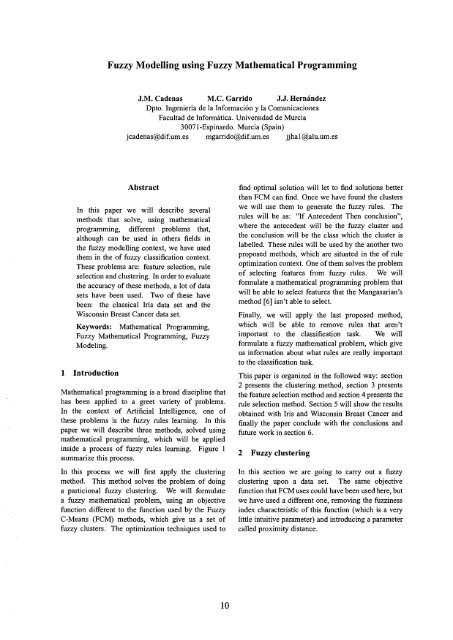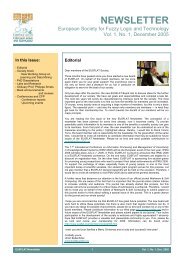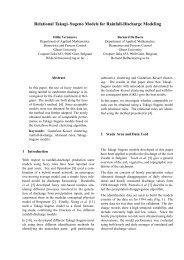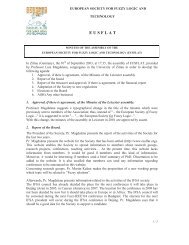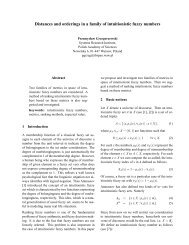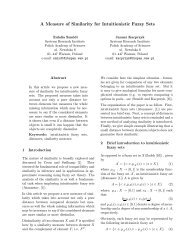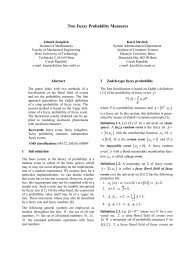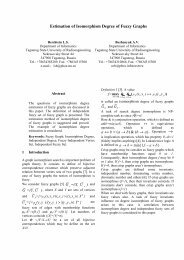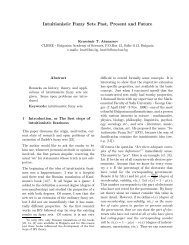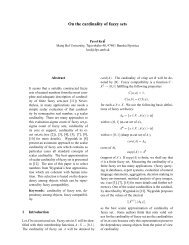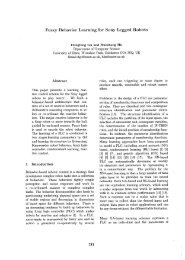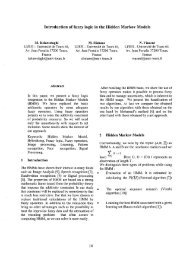Fuzzy Modelling using Fuzzy Mathematical Programming - EUSFLAT
Fuzzy Modelling using Fuzzy Mathematical Programming - EUSFLAT
Fuzzy Modelling using Fuzzy Mathematical Programming - EUSFLAT
You also want an ePaper? Increase the reach of your titles
YUMPU automatically turns print PDFs into web optimized ePapers that Google loves.
<strong>Fuzzy</strong> <strong>Modelling</strong> <strong>using</strong> <strong>Fuzzy</strong> <strong>Mathematical</strong> <strong>Programming</strong><br />
J.M. Cadenas M.C. Garrido J.J. Hernandez<br />
Dpto. Ingenieria de la Information y la Comunicaciones<br />
Facultad de Informitica. Universidad de Murcia<br />
3007 1 -Espinardo. Murcia (Spain)<br />
jcadenas@dif.um.es mgamdo@dif.um.es jjhalBa1u.um.e~<br />
Abstract<br />
In this paper we will describe several<br />
methods that solve, <strong>using</strong> mathematical<br />
programming, different problems that,<br />
although can be used in others fields in<br />
the fuzzy modelling context, we have used<br />
them in the of fuzzy classification context.<br />
These problems are: feature selection, rule<br />
selection and clustering. In order to evaluate<br />
the accuracy of these methods, a lot of data<br />
sets have been used. Two of these have<br />
been: the classical Iris data set and the<br />
Wisconsin Breast Cancer data set.<br />
Keywords: <strong>Mathematical</strong> <strong>Programming</strong>,<br />
<strong>Fuzzy</strong> <strong>Mathematical</strong> <strong>Programming</strong>, <strong>Fuzzy</strong><br />
Modeling.<br />
1 Introduction<br />
<strong>Mathematical</strong> programming is a broad discipline that<br />
has been applied to a greet variety of problems.<br />
In the context of Artificial Intelligence, one of<br />
these problems is the fuzzy rules learning. In this<br />
paper we will describe three methods, solved <strong>using</strong><br />
mathematical programming, which will be applied<br />
inside a process of fuzzy rules learning. Figure 1<br />
summarize this process.<br />
In this process we will first apply the clustering<br />
method. This method solves the problem of doing<br />
a particional fuzzy clustering. We will formulate<br />
a fuzzy mathematical problem, <strong>using</strong> an objective<br />
function different to the function used by the <strong>Fuzzy</strong><br />
C-Means (FCM) methods, which give us a set of<br />
fuzzy clusters. The optimization techniques used to<br />
find optimal solution will let to find solutions better<br />
than FCM can find. Once we have found the clusters<br />
we will use them to generate the fuzzy rules. The<br />
rules will be as: "If Antecedent Then conclusion",<br />
where the antecedent will be the fuzzy cluster and<br />
the conclusion will be the class which the cluster is<br />
labelled. These rules will be used by the another two<br />
proposed methods, which are situated in the of rule<br />
optimization context. One of them solves the problem<br />
of selecting features from fuzzy rules. We will<br />
formulate a mathematical programming problem that<br />
will be able to select features that the Mangasarian's<br />
method [6] isn't able to select.<br />
Finally, we will apply the last proposed method,<br />
which will be able to remove rules that aren't<br />
important to the classification task. We will<br />
formulate a fuzzy mathematical problem, which give<br />
us information about what rules are really important<br />
to the classification task.<br />
This paper is organized in the followed way: section<br />
2 presents the clustering method, section 3 presents<br />
the feature selection method and section 4 presents the<br />
rule selection method. Section 5 will show the results<br />
obtained with Iris and Wisconsin Breast Cancer and<br />
finally the paper conclude with the conclusions and<br />
hture work in section 6.<br />
2 <strong>Fuzzy</strong> clustering<br />
In this section we are going to cany out a fuzzy<br />
clustering upon a data set. The same objective<br />
function that FCM uses could have been used here, but<br />
we have used a different one, removing the fuzziness<br />
index characteristic of this function (which is a very<br />
little intuitive parameter) and introducing a parameter<br />
called proximity distance.
4<br />
Data Set Rules Set<br />
<strong>Fuzzy</strong> clustering<br />
method<br />
The proximity distance extends the idea of classic<br />
k-mean algorithm. In this algorithm only is added the<br />
distance of the example from the nearest center.<br />
The idea that we propose is that every example must<br />
add with a center if the distance of this centre from the<br />
example is smaller than the distance of the example<br />
from the nearest centre added with the proximity<br />
distance. These distances have a membership value,<br />
which describes the degree of belonging of the<br />
example to the cluster. These degrees of belonging<br />
are normalized.<br />
The fkzy mathematical programming problem that<br />
solves this is:<br />
j= 1 \vi. i<br />
Pij = max(0, (min<br />
with mini = ,min {d;)<br />
~=l,..,k<br />
Figure 1 : <strong>Fuzzy</strong> rules learning process<br />
Rules selection<br />
method<br />
Set of fuzzy Set of fuuy rules only<br />
clustering with selected features<br />
Set of fuzzy<br />
- Rules generation<br />
Where dij is the distance of the i-th example to the j-th<br />
center, and pij is a membership value which describes<br />
the degree of belonging (still not normalized) of the<br />
i-th example to the j-th cluster. In order to normalize<br />
the degrees of belonging, these are divided by q. The<br />
fuzzy constraint controls the proximity distance value<br />
(tij). When this distance is 0 then we are in the case of<br />
rules<br />
Feature selection<br />
from rules method<br />
classic k-mean problem. When this distance is bigger<br />
than 0 then we are in the case of fkzy clusters.<br />
Using the solution of the problem, the fuzzy clusters<br />
are generated. This clusters are defined by a mean and<br />
a covariance matrix. Using the fuzzy clusters the rules<br />
are generated. The rules are as: "If Antecedent Then<br />
conclusion", where the antecedent is the fuzzy cluster<br />
and the conclusion is the class which the cluster is<br />
labelled.<br />
3 Feature selection from rules<br />
In this section we are going to select features from<br />
the rules generated in the previous section. The rules<br />
that we have used have been Gaussian defined by a<br />
mean (m) and a covariance matrix. However, the<br />
idea that we propose can be generalized to every<br />
type of rule. We select features looking for a linear<br />
discriminant between each pair of rules that have a<br />
different conclusion, that is, labelled with a different<br />
class, and that use as few of the features as possible.<br />
At least, the features that use the discriminant will<br />
be the features that we will select. The error that<br />
a discriminant commits separating two rules is the<br />
degree of belonging of the discriminant's point that<br />
have the biggest degree of belonging to any of the<br />
two rules. In order to determine this, we have to<br />
transform the Gaussian to Gaussian with mean equal<br />
to 0 and variance equal to 1. This transforms the<br />
points from original space to the destiny space in<br />
the following way, y = A'/~v' (X - m) = O(X - m) ,<br />
where x represents the points of the original space<br />
and y the points of the destiny space. A is the<br />
eigenvalues matrix of the covariance matrix of the<br />
n
Gaussian, and V is the eigenvectors matrix. Calling The fist constraint is the fuzzy constraint. Maxcover<br />
C; to the center of the fizzy set A, of the rule R,, w;,<br />
and yi, to the discriminant between the sets A, and<br />
A,, and 0; to the matrix 0 of the fkzy set A,, which<br />
represents the cover of the whole set of rules, and<br />
n z maxk{(l - e-avj)p;,} represents the cover of the<br />
/=I,..,<br />
can be computed before beginning the optimization<br />
process, the mathematical programming problem can<br />
selected rules, where b, is the degree of belonging of<br />
the i-th example to the j-th cluster and a > 0 (a good<br />
be formulated in the following way: value is a=5).<br />
claw(j) # clarr(i)<br />
5 Experiments<br />
We have applied the learning process with two sets:<br />
the classical Iris data set (IRIS) and the Wisconsin<br />
Breast Cancer data set (WBC). A table that summarize<br />
the results obtained is:<br />
1<br />
I<br />
WS<br />
I I Our Pmw I FCM<br />
3 mles, 2 fealurer + 5 crrors<br />
4 ruler -+ IS m<br />
11 6 rules, 2 features -+ 4 mom I<br />
n<br />
I GC-Anfir<br />
4 rules + 3 mon<br />
3 rules,4 features -+ 22 eron<br />
WBC<br />
13 rules + 7 crrors<br />
11 8 ~ b . icalwcs 4 -r 20 crron I<br />
S.t. : GC-ARfis+HIXGA I MFGN<br />
yl;, = y;j - wi,ci,<br />
pij = y;, - w. .c.<br />
11 17 V ij, j>i<br />
-w;,C; + yij + 1 5 0<br />
class^)# class(i)<br />
w,c; - yij + 1 < 0<br />
-v..
Acknowledgements<br />
The authors thank the Comision Interministerial de<br />
Ciencia y Tecnologa (CICyT) for the support given<br />
to this work under the projects 1 FD97-0255-C03-0 1<br />
and TIC2000-0062-P4-03.<br />
References<br />
[I ] J.M. Cadenas, J.L. Verdegay (1999). Modelos de<br />
Optimizaci6n con datos Imprecisos. Servicio de<br />
Publicaciones. Universidad de Murcia. 1999.<br />
[2] M. Delgado, A. G6mez-Skarmeta, F. Martin<br />
(1995). Un enfoque aproximativo para la<br />
generaci6n de reglas mediante anilisis cluster.<br />
V Congreso Espaiiol sobre Tecnologias y lbgica<br />
fuzzy, pp.43-48. 1995.<br />
[3] A. Flores, J.M. Cadenas, F. Martin (1998).<br />
A local geometrical propierties application to<br />
fuzzy clustering. Int. Jour. <strong>Fuzzy</strong> Sets and<br />
Systems 100, pp. 245-256. 1998.<br />
[4] A. Flores, J.M. Cadenas, F. Martn (1999).<br />
Membership Function in the <strong>Fuzzy</strong> C-Means<br />
algorithm. Int. Jour. <strong>Fuzzy</strong> Sets and Systems 101<br />
(I), pp. 49-58. 1999.<br />
[5] H. Liu, H. Motoda (1998). Feature selection for<br />
knowledge discovery and data mining. Kluwer<br />
Academic Publishers. 1998.<br />
[6] O.L. Mangasarian (1 997). <strong>Mathematical</strong><br />
<strong>Programming</strong> in Data Mining. Data Mining<br />
and Knowledge Discovery 1, 1 83-20 1. Kluwer<br />
Academic Publishers. 1997.<br />
[7] A. Ruiz, P.E. Lopez de Tenel, M.C. Garrido<br />
(1999). Probabilistic Inference from Arbitrary<br />
Uncertainty <strong>using</strong> Mistures of Factorized<br />
Generalized Gaussians. Jorunal of Artificial<br />
Intelligent Research, vol. 9, pp. 167-21 7. 1998.


